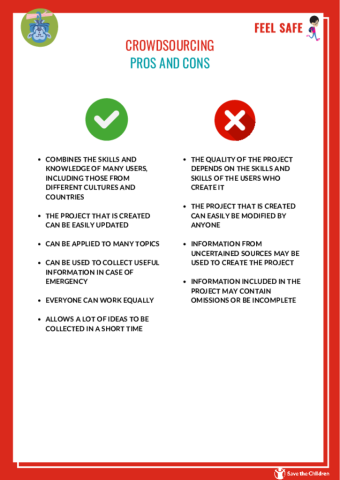Crowdsourcing
Objectives
- Learn about crowdsourcing by experiencing it first-hand
- Reinforce technological knowledge
- Get to know how to correctly use digital technologies to share information
STEP BY STEP
Before starting
The teacher introduces the definition of crowdsourcing in the glossary:
Crowdsourcing: an online project whose realisation requires the contribution of many people at the same time.
Having introduced the definition, the teacher can ask the class the following questions: "Have you ever heard of crowdsourcing?" "Can you think of an example?" "What about Wikipedia?" "Do you know what it is?"
Before going on with the activity, the meaning of the term "crowdsourcing" is further explored by reading the history of Wikipedia and reflecting on why this information-gathering system is gaining popularity nowadays.
How to crowdsource
The teacher then asks the class to elaborate a crowdsourcing project starting from this text:
"In every territory there are risks. To ensure that a risk The possibility that a phenomenon may cause harm to people, settlements and the environment in a given period of time and in a given area does not turn into a disaster, it is necessary for the entire community to participate and be informed. In the culture of safety A condition that makes one feel that one is not in danger or that a risk can be prevented or reduced , we speak of forecasting Phase of the risk management cycle that aims to identify and study possible risk scenarios. , prevention, as phases of the disaster management cycle. In addition to these phases, mitigation, which reduces or minimises negative impacts, is crucial. People exposed to risk and the territory have vulnerabilities. It is up to each of us to participate to increase the resilience The ability to cope with calamitous events and overcome their effects of the whole community."
First, the class can consult the glossary together and enter the definitions of the words highlighted in the text.
Research the missing information
The class is divided into groups of 3 or 4. Each group is to work on the text proposed by the teacher with the common definitions already found. The activity consists of finding as many definitions as possible for the words that are not highlighted and inserting them into the text. All groups will have one pc and 5 minutes to find the definitions, which they will then transcribe on a sheet of paper provided by the teacher.
Before using the PC, each group will have 5 minutes to work out their research strategy following these guidelines:
- Decide how many and which words to search for
- Decide who will carry out the search
- Decide who will transcribe the definition found on the Internet
Once the research is finished, the final text is read out. The group that has entered the highest number of definitions for the words wins the challenge.
Concluding thoughts
Crowdsourcing is about creating shared projects. What do you think are the pros and cons?
The teacher can share with the class a list of Pros and Cons (see attached "Crowdsourcing - Pros and Cons" below) and suggest some food for thought such as:
- Crowdsourcing allows the passive consumer of information to become an active creator
- The collection of ideas is fast and vast
- Everyone can participate equally in a shared project
- Crowdsourcing can help to unite cultures, countries, stories, data and can support the creation of a project.
- Even in emergencies, crowdsourcing makes it possible to gather a lot of useful information about what is happening. The teacher can use the story of Ushahidi Crowdmap as an example (link).
Il crowdsourcing consiste nel creare progetti condivisi. Quali sono, secondo te, i pro e i contro?
L’insegnate può condividere con la classe i Pro e Contro del Crowdsourcing (vedi allegato "Il Crowdsourcing - Pro e Contro" in basso) e suggerire alcuni spunti di riflessione quali:
- Il crowdsourcing permette al consumatore passivo di informazioni di diventare creatore attivo
- La raccolta di idee è veloce e vastissima
- Tutti possono partecipare in egual misura a un progetto condiviso
- Il crowdsourcing può contribuire ad unire culture, paesi, storie, dati e può essere di supporto per la creazione di un progetto
- Anche in caso di emergenza il crowdsourcing permette di raccogliere moltissime informazioni utili per conoscere quello che sta succedendo. Si può utilizzare questa storia della Crowdmap di Ushahidi come esempio (link).

Add new comment